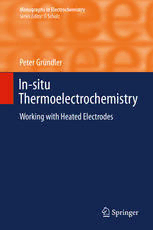
In-situ Thermoelectrochemistry: Working with Heated Electrodes PDF
Preview In-situ Thermoelectrochemistry: Working with Heated Electrodes
Monographs in Electrochemistry Series Editor: F. Scholz Peter Gründler In-situ Thermoelectrochemistry Working with Heated Electrodes In-situ Thermoelectrochemistry Monographs in Electrochemistry SeriesEditor:FritzScholz,UniversityofGreifswald,Germany Surprisingly,alargenumberofimportanttopicsinelectrochemistryisnotcovered by up-to-date monographs and series on the market, some topics are even not covered at all. The series Monographs in Electrochemistry fills this gap by pub- lishing indepth monographs written by experienced and distinguished electrochemists,coveringboththeoryandapplications.Thefocusissetonexisting aswellasemergingmethodsforresearchers,engineers,andpractitionersactivein themanyandofteninterdisciplinaryfields,whereelectrochemistryplaysakeyrole. These fields will range – among others – from analytical and environmental sciencestosensors,materialssciencesandbiochemicalresearch. More information about this series at http://www.springer.com/series/7386 Peter Gru¨ndler In-situ Thermoelectrochemistry Working with Heated Electrodes PeterGru¨ndler InstituteforSolidStateResearch LeibnizInstituteforSolidStateandMaterialsResearchDresden(IFW) Dresden Germany ISSN1865-1836 ISSN1865-1844(electronic) ISBN978-3-662-45817-4 ISBN978-3-662-45818-1(eBook) DOI10.1007/978-3-662-45818-1 SpringerHeidelbergNewYorkDordrechtLondon LibraryofCongressControlNumber:2015932767 ©Springer-VerlagBerlinHeidelberg2015 Thisworkissubjecttocopyright.AllrightsarereservedbythePublisher,whetherthewholeorpart of the material is concerned, specifically the rights of translation, reprinting, reuse of illustrations, recitation,broadcasting,reproductiononmicrofilmsorinanyotherphysicalway,andtransmissionor informationstorageandretrieval,electronicadaptation,computersoftware,orbysimilarordissimilar methodologynowknownorhereafterdeveloped.Exemptedfromthislegalreservationarebriefexcerpts inconnectionwithreviewsorscholarlyanalysisormaterialsuppliedspecificallyforthepurposeofbeing enteredandexecutedonacomputersystem,forexclusiveusebythepurchaserofthework.Duplication ofthispublicationorpartsthereofispermittedonlyundertheprovisionsoftheCopyrightLawofthe Publisher’s location, in its current version, and permission for use must always be obtained from Springer.PermissionsforusemaybeobtainedthroughRightsLinkattheCopyrightClearanceCenter. ViolationsareliabletoprosecutionundertherespectiveCopyrightLaw. The use of general descriptive names, registered names, trademarks, service marks, etc. in this publicationdoesnotimply,evenintheabsenceofaspecificstatement,thatsuchnamesareexempt fromtherelevantprotectivelawsandregulationsandthereforefreeforgeneraluse. While the advice and information in this book are believed to be true and accurate at the date of publication,neithertheauthorsnortheeditorsnorthepublishercanacceptanylegalresponsibilityfor anyerrorsoromissionsthatmaybemade.Thepublishermakesnowarranty,expressorimplied,with respecttothematerialcontainedherein. Printedonacid-freepaper SpringerispartofSpringerScience+BusinessMedia(www.springer.com) Preface of the Editor Ihadthefortunetoknowtheauthorofthisbooksinceabout45years,whenPeter Gru¨ndlerwas still adocent at the Universityof Leipzig andgave talks on confer- ences on coulometry and stripping voltammetric detection of the end point of titrations.Irememberthathisresearchalwaysshowedthathecouldtakeadvantage ofaprofoundabilitytobuilduphisownelectronicmeasuringequipment.Thiswas especiallyimportantattimeswhenmoderninstrumentationfromWesterncompa- nieswasverydifficult,ifnotimpossible,topurchaseinEastGermany.Then,after thereunificationofGermany,whenPeterGru¨ndleralreadywasfullProfessoratthe UniversityofRostock,IhavewitnessedfromtheverybeginningPeterGru¨ndler’s ingeniousdevelopmentsofwhathehascalledatthattime“hot-wireelectrochem- istry”.Duringthefollowingyearsofveryhardwork,hehas,togetherwithanumber ofdedicatedco-workers,achievedtheestablishmentofacompletelynewtechnique forelectrochemicalinvestigations,whichhenowdescribesinthisbookentitled“In situThermoelectrochemistry–WorkingwithHeatedElectrodes”.Iamveryhappy thatPeterGru¨ndlerhasdecidedtodescribethebackground,thefoundationsandthe experimental achievements of his technique in book form, because not only this willhelptopopularizethisimportantnewdirectioninelectrochemistry,butitwill also efficiently help to convince more electrochemists, analytical chemists and maybe also physicists and biologists to apply the technique for solving their own problems.Theprospectsforapplicationsofheatedelectrodesarealmostlimitless, andwecanexpectanavalancheofnewresearchworkwiththisnewexperimental means. Greifswald,Germany FritzScholz October2014 v ThiSisaFMBlankPage Preface of the Author Theyear1989wasatimeofgreatchangeandgreatopportunitiesinGermanyand the whole of Europe. When the author of this book—then a freshly appointed professor at an old university in Eastern Germany (the GDR)—became aware of these great opportunities to conduct research freely, he remembered some older ideaswhichhadnotbeenviabletoworkonbeforethefalloftheBerlinwall.Oneof theseideaswasthequestion“whatwouldhappenifIdippedthefilamentofalight bulb into a solution, heated it, and used it as an electrode?” After some short experiments,itbecameclearthatitwasnotaproblemtomakeaheatedelectrode thisway,evenamicroelectrode.WhenasuitablePhDstudenthadbeenfoundand fundinghadbeenarranged,thefirstquestiontobeansweredwaswhetherthehigh frequencyalternatingcurrentnecessaryfortheheatingwouldallowsensitivesignal measurement inthe electrochemicalcell.At thispoint,we sufferedacatastrophic setback. It was nearly impossible to follow the tiny electrolysis current when, simultaneously, a very strong alternating current flowed through the electrode wireandgeneratedmassivedistortions.Furthermore,itturnedoutthatothergroups hadpreviouslytriedtouseanidenticalarrangementforelectrochemicalpurposes, obviouslyencounteringthesameproblem.Whatnext? Fortunately,therewasasolution—compensatetheACdistortionsbymeansofa symmetricelectrodewirearrangement.Thisworkedperfectly,andtheresultwasa technique that enabled, with negligible effort, the heating of an electrode in situ, openingupmanyusefulpossibilities,suchasefficientmicrostirringandtheability to work in overheated solvents, excite kinetically hindered substances to react, studyvolatilesubstancesathightemperatureswithoutanyloss,etc.Intheinterna- tionalscientificcommunity,theterm“hot-wireelectrochemistry”becamepopular forthistechnique.Thus,thesimpletechniquementionedabovemarkedthestartof afruitful,innovativedevelopmentinelectrochemistry.Thishasbeenverysatisfy- ing for the author of this book, who has been able to work on a subject of longstanding interest with a group of highly talented young people in a friendly atmosphere ofpoliticalfreedom. vii viii PrefaceoftheAuthor Afterbeingusedinmanydifferentregions oftheworldanddiscussedatmany conferences, hot wire electrochemistry has become part of a larger field. It has therefore been decided to summarize all the effort made to apply temperature changestothesurfaceofanelectrodeasanintentionallyvariedexternalparameter. Thehistoryofallthatisknownasthermoelectrochemistryisalsorelated,andthese areas represent the main subjects covered in this book. Experimental experiences arealsorelated,togetherwithmanyuseful“tricks”. The author hopes that this book leads to wider application of modern thermoelectrochemicalmethods. Dresden,Germany PeterGru¨ndler Acknowledgements Ithankallmyyoungfriendswhoworkedtogetherwithmeduringoneofthemost fruitful and happy periods of my life, when we worked out together the hot-wire electrochemistry.Thankyou,Tadesse,Andreas,Torsten,Andre´,MarkusandBello! I am happy and grateful that there are, among my scientific friends, such outstanding people as Joe Wang, Richard Compton, Christopher Brett and Danny Mandler.Theirinterest,thediscussionswiththemandtheirencouragementwereof invaluableuseforme. IamverygratefultomylatefriendLotharDunschwhoofferedmethechanceto continue to work with hot-wire electrochemistry after my retirement from the university,inthewonderfulatmosphereofhisgroup. Ihavetothankalsotheeditoroftheseries“MonographsinElectrochemistry”, Fritz Scholz, for his invitation to publish this monograph and for his encouragement. ix
